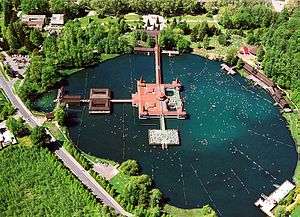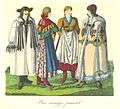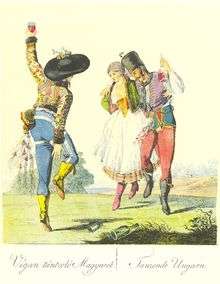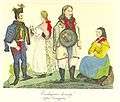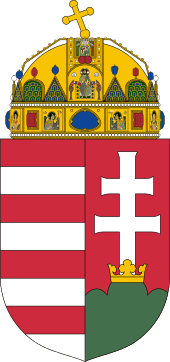Culture of Hungary
| Part of a series on the |
| Culture of Hungary |
|---|
 |
| History |
| People |
| Languages |
|
Mythology and folklore |
| Cuisine |
| Festivals |
| Religion |
| Art |
| Literature |
|
Music and performing arts |
| Sport |
|
Monuments |
|
The culture of Hungary varies across Hungary, starting from the capital city of Budapest on the Danube, to the Great Plains bordering Ukraine. Hungary has a rich folk crafts tradition, for example: embroidery, decorated pottery and carvings. Hungarian music ranges from the rhapsodies of Franz Liszt and folk music to modern songs influenced by folk music and Roma music. Hungary has a rich and colorful literature with many poets and writers although not many are known abroad due to the limited prevalence of the Hungarian language. Some noted authors include Sándor Márai and Imre Kertész, who have been gaining acclaim in recent decades. János Kodolányi was well known in Italy and Finland in the mid-20th century. Imre Kertész won the Nobel Prize in Literature in 2002. Péter Esterházy is popular in Austria and Germany, and Magda Szabó has recently become well known in Europe as well.
Architecture
Hungary is home to the largest synagogue in Europe (Great Synagogue), the largest medicinal bath in Europe (Széchenyi Medicinal Bath), the third largest church in Europe (Esztergom Basilica), the second largest territorial abbey in the world (Pannonhalma Archabbey), the second largest Baroque castle in the world (Gödöllő), and the largest Early Christian Necropolis outside Italy (Pécs).
Music
The music of Hungary consists mainly of traditional Hungarian folk music and music by prominent composers such as Ferenc Liszt (known in the West as Franz Liszt), Franz Schmidt, Dohnányi, Bartók, Kodály, and Rózsa. Traditional Hungarian music tends to have a strong dactylic rhythm, as in the Hungarian language the first syllable of each word is invariably stressed. Hungary also has a number of internationally renowned composers of contemporary classical music, including György Ligeti, György Kurtág, Péter Eötvös and Zoltán Jeney, among others.
Hungary has made many contributions to the fields of folk, popular, and classical music. Hungarian folk music is a prominent part of the national identity and continues to play a major part in Hungarian music. Hungarian folk music has been influential in neighboring areas such as Romania, Slovakia, Poland, and especially in southern Slovakia and the Romanian region of Transylvania, both home to significant numbers of Hungarians.
Broughton claims that Hungary's "infectious sound has been surprisingly influential on neighbouring countries (thanks perhaps to the common Austro-Hungarian history) and it's not uncommon to hear Hungarian-sounding tunes in Romania, Slovakia and southern Poland".[1] It is also strong in the Szabolcs-Szatmár area, and in the southwest part of Transdanubia, near the border with Croatia. The Busójárás carnival in Mohács is a major Hungarian folk music event, formerly featuring the long-established and well-regarded Bogyiszló orchestra.[2]
Hungarian classical music has long been an "experiment, made from Hungarian antedecents and on Hungarian soil, to create a conscious musical culture [using the] musical world of the folk song".[3] Although the Hungarian upper class has long had cultural and political connections with the rest of Europe, leading to an influx of European musical ideas, the rural peasants maintained their own traditions, so that by the end of the 19th century Hungarian composers could draw on rural peasant music to (re)create a Hungarian classical style.[4] For example, Béla Bartók and Zoltán Kodály, two of Hungary's most famous composers, are known for using folk themes in their music. Bartók collected folk songs from across Central Europe, including Romania and Slovakia, whilst Kodály was more interested in creating a distinctively Hungarian musical style.
During the era of Communist rule in Hungary (1944–1989), a Song Committee scoured and censored popular music for traces of subversion and ideological impurity. Since then, however, the Hungarian music industry has begun to recover, producing successful performers in the fields of jazz such as trumpeter Rudolf Tomsits, pianist-composer Károly Binder, and in a modernized form of Hungarian folk, Ferenc Sebő and Márta Sebestyén. The three giants of Hungarian rock, Illés, Metró, and Omega, remain very popular, especially Omega, which, besides Hungary, has followings in Germany and beyond. Veteran underground bands from the 1980s such as Beatrice also remain popular.
Literature


In earliest times, the Hungarian language was written in a runic-like script. The country switched to the Latin alphabet after being Christianized under the reign of Stephen I of Hungary (1000–1038). There are no existing documents from before the 11th century.
The oldest written record in Hungarian is a fragment in the Establishing charter of the abbey of Tihany (1055) which, while mostly written in Latin, contains several Hungarian terms, among them the words feheruuaru rea meneh hodu utu rea, "up the military road to Fehérvár". The oldest complete text is the Funeral Sermon and Prayer (Halotti beszéd és könyörgés) (1192–1195), a translation of a Latin sermon. The oldest poem is the Old Hungarian Laments of Mary (Ómagyar Mária-siralom), also a translation from Latin, albeit a flawed one, from the 13th century. It is also the oldest surviving Uralic poem.
Among the first chronicles about Hungarian history were Gesta Hungarorum ("Deeds of the Hungarians") by the unknown author usually called Anonymus, and Gesta Hunnorum et Hungarorum ("Deeds of the Huns and the Hungarians") by Simon Kézai, both written in Latin. These chronicles are a blend of history and legends, so they are not always historically accurate. Another chronicle is the Képes krónika (Illustrated Chronicle), which was written for Louis the Great.
Renaissance literature flourished under the reign of King Matthias (1458–1490). Janus Pannonius—even though he wrote in Latin—is considered one of the most important writers in Hungarian literature; he was also the only significant Hungarian Humanist poet of the period. The first printing house was founded during Matthias' reign by András Hess in Buda. The first book printed in Hungary was the Chronica Hungarorum. The library of King Matthias Corvinus, the Bibliotheca Corviniana, was among Europe's greatest collections of secular historical chronicles and philosophic and scientific works in the fifteenth century. In 1489, Bartolomeo della Fonte of Florence wrote that Lorenzo de Medici had founded his own Greek-Latin library after being inspired by the example of the Hungarian king. Matthias Corvinus' library is now part of UNESCO World Heritage. Two other important figures of the Hungarian Renaissance are poets Bálint Balassi and Sebestyén Tinódi Lantos.
The most important poets of the period following the reign of King Matthias were Bálint Balassi (1554–1594) and Miklós Zrínyi (1620–1664). Balassi's poetry, reflecting Medieval influences, can be divided into three groups: love poems, war poems, and religious poems. Zrínyi's most significant work, the epic Szigeti veszedelem ("Peril of Sziget" 1648–49) is written in a fashion similar to the Iliad. In the poem Zrínyi recounts the heroic Battle of Szigetvár where his great-grandfather died while defending the castle of Szigetvár. Among religious works, the most important is the Bible translation by Gáspár Károli, the Protestant pastor of Gönc, which was completed in 1590. This translation is called the Bible of Vizsoly after the town where it was first published. (See Hungarian Bible translations for more details.)
The Hungarian enlightenment followed the Western European enlightenment by about fifty years, reaching Hungary through Vienna. The first writers of the Hungarian enlightenment were, among others, Maria Theresia's bodyguards György Bessenyei and János Batsányi. The greatest poets of this period were Mihály Csokonai Vitéz and Dániel Berzsenyi. The enlightenment prompted a reform of the Hungarian language. The greatest figure in this reform was Ferenc Kazinczy. Beginning at this time, Hungarian became useful for scientific writing, and many words were coined to name new inventions.
Hungarian literature has recently gained renown outside the borders of Hungary, mostly through German, French and English translations. Some modern Hungarian authors have become popular in Germany and Italy, especially Sándor Márai, Péter Esterházy, Péter Nádas, and Imre Kertész. Kertész is a contemporary Jewish writer and Holocaust survivor who won the Nobel Prize for literature in 2002.
The classics of Hungarian literature have remained largely unknown outside Hungary. János Arany, a famous nineteenth century poet, is still much loved in Hungary, especially his collection of ballads. Arany is among several other "true classics" including Sándor Petőfi, the poet of the Revolution of 1848, Endre Ady, Mihály Babits, Dezső Kosztolányi, Attila József, and János Pilinszky. Other Hungarian authors are Ferenc Móra, Géza Gárdonyi, Zsigmond Móricz, Gyula Illyés, Albert Wass, and Magda Szabó. Vilmos Kondor has in the last years created a new trend and is mentioned as the creator of Hungarian noir (see Budapest Noir).
Film
Many Hungarians have contributed to film art and its technology, but, due to political reasons, many of them found it was easier to find success abroad. As of 1996, Hungarians working in Hollywood had received more than 136 Academy Award nominations and about 30 Academy Awards. The peak was in the decade of the 1940s when about 43 nominations were given to exiled Hungarians.
Hungarians emigrated in big numbers after several disasters following the First World War (1918) when neighbouring countries—Romania, Yugoslavia and Czechoslovakia—occupied Hungary, which subsequently lost two-thirds of its territory in 1920. There followed a communist takeover accompanied by a so-called ″red terror″ and then a reaction against it called the ″white terror″, causing a negative effect on the economy. It was at this time that Hungarian filmmakers tried their fortunes abroad, first, as did Géza von Bolváry, in the German-speaking world and later in the English-speaking world. Sound-film was invented (1918) in Germany by Dénes Mihály. With the advent of racial laws in 1939, Jewish citizens were forced to leave the country to find work. It is ironic that some of the most successful propaganda films during the Second World War for both sides were made by Hungarians: Münchhausen by Josef von Báky and "Pimpernel" Smith by Leslie Howard. With the communist takeover in 1948, more Hungarians left. After the crushed 1956 revolution, some important filmmakers left including Vilmos Zsigmond, László Kovács, Jean Badal and Peter Medák. Following the amnesty of 1960, the cultural climate eased somewhat.
Nevertheless, despite the hardships of staying at home, some Hungarians received the coveted Academy Award nominations (17 times for 20 people) and in some cases the actual Award (Ferenc Rófusz (1980), István Szabó (1981), Zsuzsa Böszörményi (1991) and co-winners Jászberényi, Perlaki and Priskin (2010) and (2014) to co-winnersImre Major and Csaba Köhegyi. The most well-known Hungarian film to date is Mephisto, by István Szabó. It won an Academy Award in the category Best Foreign Language film. The year before, in 1980, The Fly, an animation by Rófusz, became the very first Hungarian film to receive an Academy Award. The Foreign Student Academy Award went to Zsuzsa Böszörményi (1991). In 2010 the trio Márk Jászberényi, Tamás Perlaki and Gyula Priskin got the scientific and engineering award for Lustre, a software program to colorcorrect intermediates in real-time (it was first used on The Lord of the Rings). In 2014 the same prize went to three Hungarians, Tibor Madjar, Imre Major and Csaba Köhegyi(2014). Eight films have been nominated in the category Best Foreign Language Film—four nominations to István Szabo (the most nominated person in Hungary), two to Zoltán Fábri (1969, 1979) and one each to Imre Gyöngyössy/Barna Kabay and Károly Makk. Three films have been nominated for Best Short Animation:(Marcell Jankovics, Ferenc Rófusz and Géza M.Toth). Cinematographer Lajos Koltai has been nominated for best cinematography.
Academy Award nominations to people of Hungarian background include:
- Producers: Adolph Zukor One honorary award (1949), William Fox 1 nomination, Joe Pasternak One honorary award (1939), Gabriel Pascal nomination (1939), Emeric Pressburger One nomination (1949), Frank Darabont One nomination; Jules White 4 nominations (Best short subject: 1935, 1936, 1946 and 1947).
- Art Directors: William S. Darling 7 nominations (1933, 1936, 1937, 1939, 1943, 1944, 1946) / 3 wins, Vincent Korda 4 nominations (1940–42, 1962) / 1 win (1940), Joseph Kish 5 nominations (1944, 1948, 1959, 1965) / 1 win (1965), Marcel Vértes 1 nomination, Alexandre Trauner 2 nominations (1961, 1976) / 1 win (1961).
- Special effects: George Pal (György Pál) 7 nominations (1942–48) plus one Honorary award (1944).
- Scientific & Technical award: Atilla Szalay (1996).Márk Jászberényi, Tamás Perlaki and Gyula Priskin (2010). Tibor Madjar, Imre Major and Csaba Köhegyi(2014).
- Music score. Miklós Rózsa 16 nominations (1941–43, 1945–48, 1952–54, 1960 and 2 x 1962) / 3 wins (1946, 1948 and 1960: Spellbound, A Double Life and Ben-Hur, Karl Hajós 2 nomination (1944, 1945) Leo Erdödy one nomination (1944).
- Actors: Leslie Howard (László Steiner) (UK) 2 nominations (1934, 1939), Cornel Wilde one nom. (1946), Paul Lukas one win (1943).
- Screenplaywriters: Lajos Bíró one nomination (1929), co-writer: Géza Herczeg one win The Life of Emile Zola (1938) (first Hungarian to get an Academy Award), Emeric Pressburger (UK) 4 nominations (3 x 1943, 1949) / one win (1943) (most nomineed Hungarian in screenplay), Hans Szekely (as John S. Toldy) one win (1940), Frank Partos one nomination (1948), André de Toth one nomination (1950), Melchior Lengyel one nomination (1940), Robert Pirosh (US-born) one win (1949) and Frank Darabont 2 nominations (1994, 1999).
- Cinematographers: Rudolph Maté (Polish-born) 5 nominations (1940–44), John Alton (born Johann / Jenö Altmann) one win (1952), Ernest Laszlo 8 nominations (1960, 1961, 1963, 1965, 1966, 1968, 1970, 1976) / one win (1965), Vilmos Zsigmond 4 nominations (1977, 1978, 1984, 2006) / one win (1977).
- Directors: Michael Curtiz (born Mihaly Kertész): 6 nominations (1935, 2 x 1938, 1942 and 1943) / 2 wins (Casablanca), King Vidor 5 nominations (1928, 1930, 1932, 1938 and 1956) plus one Honorary (1979) and George Cukor 5 nominations (1934, 1941, 1948 and 1951) / one win (1965) My Fair Lady.
Other famous Hungarians in Hollywood are cinematographers László Kovacs ASC, Andrew László ASC. Andrew Marton directed the chariot-race in Ben-Hur. Joe Eszterhas (Esterhazy) wrote Basic Instinct and became the highest-paid writer in Hollywood history. He also wrote the Berlin Golden Bear winner "Music Box" and the first Hungarian "blockbuster", Children of Glory. Zoltan Elek won AA-award (1986) for make-up. Actors of Hungarian origin are Peter Lorre, Paul Newman (10 AA nominations/one win plus one Honorary award], Tony Curtis (2 AA nominations), Johnny Weissmüller (Tarzan) and Béla Lugosi (Dracula), Franciska Gaal, Ilona Massey, Zsa Zsa Gabor. Hedi Lamarr was half-Hungarian as was Adrien Brody (1 AA), Goldie Hawn (1 AA), Marton Csokas and Isabelle Huppert.
In Great Britain, Alexander Korda founded London films to be able to compete with Hollywood on the same terms. He produced The Third Man with music of Anton Karas. Producer Gabriel Pascal got one nomination (1939) for Pygmalion co-directed and starred by Leslie Howard. In Germany Géza von Radványi made 70-mm films to compete with Hollywood. Ephraim Kishon (b. Ferenc Hoffmann) was Israel's first nominee for best foreign-language film. He got two nominations (1964, 1972). Ján Kadár (b János Kádár) won the first AA for Czechoslovakia (1965). In Canada, Paul Sarossy is active often as Atom Egoyans cinematographer.
Home in Hungary:Some years after the failed revolution of 1956, against the Soviet-dominated communist dictatorship, the cultural climate eased up a bit and led to more creative freedom. Important films in the 1960s were directed by István Gaál: (The Falcons), András Kovács: Hideg Napok (1966), Miklós Jancsó: The Round Up (1965) (Screenplay: Hernádi Gyula, DOP: Tamás Somló), and István Szabó (The Father). Márton Keleti directed: Franz Liszt: Dreams of Love. (1970) filmed in 70 mm by István Hildebrandt. Other important filmmakers Sándor Pál, Márta Mészáros (Adoption Golden Bear Berlin 1975), Péter Gothár (Golden Lion, Venice): Time Stands Still (Cannes: Award of the Youth, 1982) (1982). Sunshine and Children of Glory are successful bigger budget movies about Hungary's turbulent past. Recent successful films include: János Szász: (Witman fiúk, DOP: Tibor Máthé 1997), György Pálfi: Hukkle (2002), (Taxidermia) (2006). The first super-studio in Hungary was Korda Studios. The next was Raleigh Studios, Budapest. Partly because of this there has been during the last years an increasing number of foreign films of mainly bigger budgets were shot in Hungary, especially in Budapest. Budapest has been nicknamed "the Hollywood at the Danube" because it is arguably by now the most Hollywood-populated place outside the US. Steven Spielberg's Munich was also partly shot in Budapest. Most of Guillermo del Toros Hellboy II was shot in Hungary. Altogether 47 foreign films were shot in Hungary in 2008, and 52 in 2009. As a comparison about 20 to 30 Hungarian movies are made annually.
Cuisine
.jpg)
Traditional dishes such as the world-famous Goulash (gulyás stew or gulyásleves soup) are popular. Dishes are often flavoured with paprika (ground red peppers), a Hungarian innovation.[5] Thick, heavy Hungarian sour cream called tejföl is often used to soften the dishes flavour. The famous Hungarian hot river fish soup called Fisherman's soup or halászlé is usually a rich mixture of several kinds of poached fish.
Other dishes include chicken paprikash, foie gras made of goose liver, pörkölt stew, vadas (game stew with vegetable gravy and dumplings), trout with almonds or salty and sweet dumplings, and túrós csusza, (dumplings with fresh quark cheese and thick sour cream). Desserts include the iconic Dobos Cake, Strudel (rétes), filled with apple, cherry, poppy seeds or cheese, Gundel pancake, plum dumplings (szilvás gombóc), somlói dumplings, dessert soups like chilled sour cherry soup, and sweet chestnut puree (gesztenyepüré) (cooked chestnuts mashed with sugar and rum, split into crumbs, and topped with whipped cream). Perec and kifli are widely popular pastries.
The csárda is the most distinctive type of Hungarian inn, an old-style tavern offering traditional cuisine and beverages. Borozó usually denotes a cozy old-fashioned wine tavern, pince is a beer or wine cellar, and a söröző is a pub offering draught beer and sometimes meals. The bisztró is an inexpensive restaurant often with self-service. The büfé is the cheapest place, although one may have to eat standing at a counter. Pastries, cake, and coffee are served at the confectionery called cukrászda, while an eszpresszó is a cafeteria.
Alcoholic beverages
Pálinka: Pálinka is a fruit brandy, distilled from fruit grown in the orchards situated on the Great Hungarian Plain. It is a spirit native to Hungary, and comes in a variety of flavours including apricot (barack) and cherry (cseresznye). However, plum (szilva) is the most common flavour. Though the flavours barely has any limits, pálinka made of strawberries or walnut are considered to be a rare and expensive delicacy, variations include pálinka sweetened with honey or fruit beds under the liquid.
Beer: Beer goes well with many traditional Hungarian dishes. The five main Hungarian breweries are Borsodi, Soproni, Arany Ászok, Kőbányai, and Dreher.
Wine: As Hugh Johnson says in The History of Wine, the territory of Hungary is ideal for wine-making. Since the fall of communism, there has been a renaissance of Hungarian wine-making. The choice of good wine is widening from year to year. The country can be divided to six wine regions, which include North-Transdanubia, Lake Balaton, South-Pannónia, Duna-region or Alföld, Upper-Hungary and Tokaj-Hegyalja. Hungarian wine regions offer a great variety of style, of which the main products of the country are elegant and full-bodied dry whites with good acidity, although complex sweet whites (Tokaj), elegant (Eger) and full-bodied robust reds (Villány and Szekszárd). The main varieties are Olaszrizling, Hárslevelű, Furmint, Pinot gris or Szürkebarát, Chardonnay (whites), Kékfrankos (or Blaufrankisch in German), Kadarka, Portugieser, Zweigelt, Cabernet sauvignon, Cabernet franc, and Merlot. The most famous wines from Hungary are Tokaji Aszú and Egri Bikavér.
Tokaji: Tokaji, meaning "of Tokaj", or "from Tokaj" in Hungarian, is used to label wines from the wine region of Tokaj-Hegyalja in Hungary. Tokaji wine has received accolades from numerous great writers and composers including Beethoven, Liszt, Schubert, and Goethe; Joseph Haydn's favorite wine was a Tokaji. Louis XV and Frederick the Great tried to outdo one another in the excellence of the vintages they stocked, when they treated guests like Voltaire to some Tokaji. Napoleon III, the last Emperor of the French, ordered 30–40 barrels of Tokaji for the Court every year. Gustav III, King of Sweden, never had any other wine to drink. In Russia, customers included Peter the Great and Empress Elizabeth of Russia.
Zwack Unicum: For over 150 years, a blend of 40 Hungarian herbs has been used to create the liqueur Unicum. Unicum is a bitter, dark-coloured liqueur that can be drunk as an apéritif or after a meal, thus helping the digestion. The recipe is held secret by the Zwack family.
Spa culture
Hungary is a land of thermal water. A passion for spa culture and Hungarian history have been connected from the very beginning. It has been shown that Hungarian spa culture is multicultural. The basis of this claim is architecture: Hungarian spas feature Roman, Greek, Turkish, and northern country architectural elements. Due to an advantageous geographical location, thermal water can be found with good quality and in great quantities on over 80% of Hungary's territory.
The Romans heralded the first age of spa in Hungary, the remains of their bath complexes are still to be seen in Óbuda, to this day. The spa culture was revived during the Turkish Invasion, who used the thermal springs of Buda for the construction of a number of bathhouses, some of which are still functioning (such as Király Baths and Rudas Baths). In the 19th century, the advancement in deep drilling and medical science provided the springboard for a further leap in bathing culture. Grand spas such as Gellért Baths, Lukács Baths, Margaret Island, and Széchenyi Medicinal Bath are a reflection of this resurgence in popularity. Approximately 1,500 thermal springs can be found in Hungary. About half of these are used for bathing.
The spa culture has a nearly 2,000 year history in Budapest. Budapest has the richest supply of thermal water among the capitals of the world. There are approximately 450 public baths in Hungary. Nowadays the trend shows that bath operators are modernizing their facilities and expanding the services offered. A total of 50 of the 160 public baths are qualified as spas throughout the country. Services are offered for healing purposes. These spas provide every type of balneal and physical therapy.
The wine-growing terroir of Egerszalók
The spa at Egerszalók is noted for being situated in one of the principal vine-growing regions of Hungary, and persons who wish to enjoy a terroir experience can attend the spa and drink the local wine. Egerszalók is also notable for human-caused geological morphology; when the spa was expanded by the post-World War II government in 1961, the flow of supersaturated mineral water sharply increased, leading to the deposition of a hillside of shining white travertine.
The thermal lake of Hévíz
The thermal lake of Hévíz is the largest biologically active, natural thermal lake of the world. The oldest and most well-known bath of Hungary, in accordance with records from the Roman era, has a history of 2,000 years. The Hévíz treatment, in its present sense, also dates back more than 200 years.
The 4.4 ha lake is fed by its spring rushing up at a depth of 38 m, containing sulphur, radium, and minerals. Due to the high water output of the spring, the water of the lake is completely changed within 48 hours. The water of the Hévíz Lake is equally rich in dissolved substances and gases, combining the favourable effects of naturally carbonated medicinal waters and those containing sulphur, calcium, magnesium, hydrogen-carbonate, as well as those with a slightly radioactive content. The medicinal Hévíz mud, which is unique of its kind, contains both organic and inorganic substances and the radium-salts and reduced sulphuric solutions in it represent special medicinal factors. The temperature of the water is 23–25 °C in winter and 33–36 °C in summer.
Folk dance
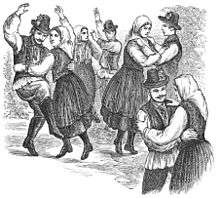
- Ugrós (Jumping dances): Old style dances dating back to the Middle Ages. Solo or couple dances accompanied by old style music, shepherd and other solo man's dances from Transylvania, and marching dances along with remnants of medieval weapon dances belong in this group.
- Karikázó: a circle dance performed by only women, and accompanied by singing of folksongs.
- Csárdás: New style dances developed in the 18th and 19th centuries, is the Hungarian name for the national dances, with Hungarian embroidered costumes and energetic music. From the men's intricate bootslapping dances to the ancient women's circle dances, Csárdás demonstrates the infectious exuberance of the Hungarian folk dancing still celebrated in the villages.
- Verbunkos: a solo man's dance evolved from the recruiting performances of the Austro-Hungarian army.
- The Legényes: It is a men's solo dance done by the ethnic Hungarian people living in the Kalotaszeg region of Transylvania. Although usually danced by young men, it can be also danced by older men. The dance is performed freestyle usually by one dancer at a time in front of the band. Women participate in the dance by standing in lines to the side and sing/shout verses while the men dance. Each lad does a number of points (dance phrases) typically 4 to 8 without repetition. Each point consists of 4 parts, each lasting 4 counts. The first part is usually the same for everyone (there are only a few variations).
Embroidery

It was in the beginning of the 18th century that the present style of Hungarian folk art took shape, incorporating both Renaissance and Baroque elements, depending on the area, as well as Persian Sassanide influences. Flowers and leaves, sometimes a bird or a spiral ornament, are the principal decorative themes. The most frequent ornament is a flower with a centerpiece resembling the eye of a peacock's feather.
Nearly all the manifestations of folk art practiced elsewhere in Europe, also flourished among the Magyar peasantry at one time or another, their ceramics and textile being the most highly developed of all.
The finest achievements in their textile arts are the embroideries which vary from region to region. Those of Kalotaszeg in Transylvania are charming products of Oriental design, sewn chiefly in a single color - red, blue, or black. Soft in line, the embroideries are applied on altar cloths, pillow cases and sheets.
In Hungary, proper Sárköz (a historical area in Tolna) in Transdanubia and the Matyóföld in the Great Hungarian Plain produce the finest embroideries. In the Sárköz region, the women's caps show black and white designs as delicate as lace and give evidence of the people's wonderfully subtle artistic feeling. The embroidery motifs applied to women's wear have also been transposed to tablecloths and runners suitable for modern use as wall decorations.
Ceramics
Black pottery
These vessels, made of black clay, reflect more than three hundred years of traditional Transdanubian folk patterns and shapes. No two are precisely alike, since all work is done by hand, including both the shaping and the decorating. The imprints are made by the thumb or a finger of the ceramist who makes the piece.
Herend Porcelain
Founded in 1826, Herend Porcelain is one of the world's largest ceramic factories, specializing in luxury hand painted and gilded porcelain. In the mid-19th century, it was purveyor to the Habsburg Dynasty and aristocratic customers throughout Europe. Many of its classic patterns are still in production. After the fall of communism in Hungary, the factory was privatized and is now 75% owned by its management and workers, exporting to over 60 countries of the world.[6]
Hungarian domestic animals
There are special Hungarian species of domestic animals which are seen as national symbols in Hungary.
- Long-horn Hungarian Grey Cattle - Hungarian breed, traditionally kept in the open full year. Nowadays, they are raised for infant food due to natural, healthy meat.
- Dogs
 A female Vizsla
A female Vizsla- Hungarian Vizsla - one of the oldest hunting dogs in the world. The ancestors of this dog came into the Carpathian Basin with the nomadic Hungarian tribes.
- Puli - small shepherd dog
- Komondor - large shepherd dog, was brought to Hungary a thousand years ago by nomadic Magyars.
- Kuvasz - large shepherd dog
- Pumi - small shepherd dog
- Magyar Agár (Hungarian Greyhound) was already known in the 8th century. It is as old as the Vizsla.
- Transylvanian Bloodhound - Hungarian hound
- Mudi - shepherd dog
- Hungarian thoroughbred horses - a mid-19th century mixture of the best Arab and English race horse characteristics.
- Mangalica, a breed of pig, characterised by their long curly hair and relatively fatty meat, which makes them ideal for making sausages and salami.
Sport
Only seven countries (USA, USSR, UK, France, Italy, China, and Germany) have won more Summer Olympic gold medals than Hungary. Hungary has the second most Olympic gold medals per capita in the Summer Olympics. Hungary has the ninth highest, out of 211 participating nations, all-time total medal count for the Olympic Games, with a total of 465 medals. This despite the fact that Hungary was punished and barred from participation in the 1920 and 1984 Olympics. In the Summer Olympics, Hungary was always been among the top 10 best nations (in gold medal count) between 1928 and 1996, when they were allowed to compete. Hungary had the third most gold medals in 1936, 1952, 1956, and 1960. See: All-time Olympic Games medal table (2008 data)
Among the most famous Hungarians is footballer Ferenc Puskás (1927–2006). He scored 84 goals in 85 internationals for Hungary, and 511 goals in 533 matches in the Hungarian and Spanish leagues. Puskás played in the 1954 FIFA World Cup Final against West Germany. In 1958, after the Hungarian Revolution, he emigrated to Spain, where he played on the legendary Real Madrid team that also included Alfredo Di Stéfano and Francisco Gento.
Hungarians are also known for their prowess at water sports, mainly swimming, water polo (See: Water polo at the Summer Olympics) (in which they defeated the Soviet team in 1956), and canoeing (they have won multiple medals). Despite being landlocked, the presence of two major rivers (the Duna and the Tisza) and a major lake (Balaton), provide excellent opportunities to practice water sports. In recent years there has also been a steady rise in the number of golfers in the country; the sport has developed much over the past 20 years (after the fall of Socialism), but the economic situation hinders further development of golf courses.
Some of the world's best sabre fencing athletes have historically hailed from Hungary. The Hungarian national ice hockey team also qualified for their first IIHF World Championship in more than 70 years.
Folk costumes (17–19th century)
See also
- List of Hungarians
- List of museums in Hungary
- Renaissance architecture in Central Europe
- National symbols of Hungary
References
- ↑ Szalipszki, pg.12
Refers to the country as "widely considered" to be a "home of music". - ↑ Broughton, pg. 159-167
- ↑ Szabolcsi, The Specific Conditions of Hungarian Musical Development
"Every experiment, made from Hungarian antedecents and on Hungarian soil, to create a conscious musical culture (music written by composers, as different from folk music), had instinctively or consciously striven to develop widely and universally the musical world of the folk song. Folk poetry and folk music were deeply embedded in the collective Hungarian people’s culture, and this unity did not cease to be effective even when it was given from and expression by individual creative artists, performers and poets." - ↑ Szabolcsi
- ↑ "Sulinet: Magyar növény-e a paprika?". Sulinet.hu. Archived from the original on 2008-06-20. Retrieved 2008-11-21.
- ↑ Herend Porcelain Manufactory Ltd
External links
- Culture of Hungary (Film, Fine arts, Folklore, Literature, Music, Press and Theatre) summarized at the administrative website of Hungary
- Some Hungarian proverbs reflecting the history and culture of the county


